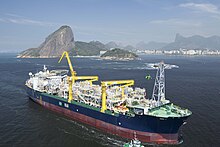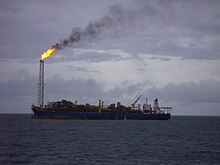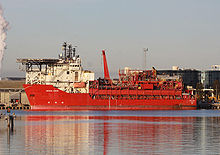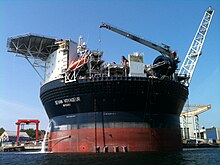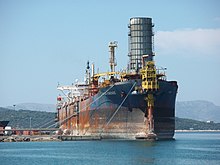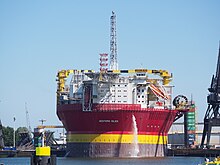
An oil platform, oil rig, offshore platform, or oil and/or gas production platform is a large structure with facilities to extract, and process petroleum and natural gas that lie in rock formations beneath the seabed. Many oil platforms will also contain facilities to accommodate their workforce, although it is also common for there to be a separate accommodation platform bridge linked to the production platform. Most commonly, oil platforms engage in activities on the continental shelf, though they can also be used in lakes, inshore waters, and inland seas. Depending on the circumstances, the platform may be fixed to the ocean floor, consist of an artificial island, or float. In some arrangements the main facility may have storage facilities for the processed oil. Remote subsea wells may also be connected to a platform by flow lines and by umbilical connections. These sub-sea solutions may consist of one or more subsea wells or of one or more manifold centres for multiple wells.

Malaysia Marine and Heavy Engineering Holdings Berhad is a Malaysian owned shipbuilding and heavy engineering industries company. It was formerly known as Malaysia Shipyard and Engineering Sdn Bhd. MHB has been long involved in oil and gas engineering and construction works.

SBM Offshore N.V. is a Dutch-based global group of companies selling systems and services to the offshore oil and gas industry. Its constituent companies started their offshore activities in the early 1950s and SBM subsequently became a pioneer in single buoy moorings (SBM) systems. The firm leases and operates Floating Production Storage and Offloading vessels, and is involved in the design and engineering, construction, installation, operation and maintenance of floating production equipment for the offshore Oils and Gas industry. It is a main board listed company on the Euronext Amsterdam stock exchange and has been a member of the AEX index since 2003. It has been engulfed by a massive corruption scandal in Brazil.

BW Group is a maritime company involved in shipping, floating gas infrastructure and deep-water oil & gas production. The company has over 350 vessels managed by an international team of over 7000 staff worldwide. The group was founded by Sir Yue-Kong Pao in Hong Kong in 1955 as World-Wide Shipping. In 2003, the company acquired Bergesen d.y. ASA, Norway's largest shipping company, which was founded in 1935 by Sigval Bergesen the Younger. In 2005, the business was re-branded as BW. With its LNG and LPG fleets combined, BW Group owns and operates the world's largest gas shipping fleet of more than 115 gas vessels, including four FSRUs. Hafnia, a member of the BW Group, operates the world's largest fleet of oil product tankers, and BW Offshore comprises the second largest number of floating oil and gas production units (FPSOs). BW's controlled fleet of over 350 ships also includes crude oil supertankers and dry bulk carriers.
BW Offshore Limited is a global owner and operator of floating production storage and offloading (FPSO) vessels. The company is listed on Oslo Stock Exchange. The company has its headquarters in Singapore and Oslo, Norway but operates internationally. The largest owner is BW Group Limited with 49.3% of the shares.
Aker Floating Production is a Norwegian Floating Production Storage and Offloading vessel operator. The company is part of the Aker Group with Aker ASA owning 44.27% of the company. It is listed on Oslo Stock Exchange.
The Bonga Field is an oilfield in Nigeria. It was located in License block OPL 212 off the Nigerian coast, which was renamed OML 118 in February 2000. The field covers approximately 60 km2 in an average water depth of 1,000 metres (3,300 ft). The field was discovered in 1996, with government approval for its development given in 2002. The field began first production in November 2005. The field is worked via an FPSO vessel. The field produces both petroleum and natural gas; the petroleum is offloaded to tankers while the gas is piped back to Nigeria where it is exported via an LNG plant. The field contains approximately 6,000 mm barrels of oil.
Gulf Gateway Deepwater Port was the first offshore liquefied natural gas LNG import facility.
LNG Hrvatska d.o.o. is a company that operates a floating liquefied natural gas (LNG) regasification terminal in Omišalj on the island of Krk, Croatia. It commenced operations on 1 January 2021, with full capacity booked for the next three years.
Offshore concrete structures have been in use successfully for about 50 years. They serve the same purpose as their steel counterparts in the oil and gas production and storage. The first concrete oil platform has been installed in the North Sea in the Ekofisk field in 1973 by Phillips Petroleum. Since then 47 major concrete offshore structures have been built.

The FPSO Noble Seillean was a dynamically positioned floating oil production, storage and offloading vessel.

Qatar Gas Transport Company Limited, commonly known as Nakilat is a Qatari shipping and maritime company. Its LNG shipping fleet is the largest in the world, comprising 69 vessels. The company also jointly owns one Floating Storage Regasification Unit (FSRU) and 4 very large LPG carriers (VLGCs). Through its in-house shipmanagement, Nakilat manages and operates the four very large LPG carriers and 14 LNG carriers.
GL Noble Denton is one of the oil and gas businesses of DNV GL, headquartered in Hamburg, Germany and London, UK. The company is an independent technical advisor to industry operators across the world.
A floating liquefied natural gas (FLNG) facility, is a floating production storage and offloading unit that conducts liquefied natural gas (LNG) operations for developing offshore natural gas resources. Floating above an offshore natural gas field, the FLNG facility produces, liquefied stores and transfers LNG at sea before carriers ship it directly to markets.

EMAS is a global offshore contractor and provider of integrated offshore solutions to the oil and gas (O&G) industry and operating brand for Ezra Holdings. The business was founded in 1992 and is headquartered in Singapore. It began in Asia Pacific in the maritime industry with a fleet of vessels. The company quickly expanded, listing EMAS on the Singapore Exchange in 2003, and adding fabrication facilities in Vietnam. Over the next few years, EMAS added its construction and production division, listed EOC Limited on the Oslo Stock Exchange in 2007 and created an energy division, offering onshore drilling, offshore drilling and well services. In 2011, EMAS embarked on a highly strategic acquisition of Aker Marine Contractors, a subsea construction and installation technology group.
Prelude FLNG is a floating liquefied natural gas platform owned by Shell plc and built by the Technip–Samsung Consortium (TSC) in South Korea for a joint venture between Royal Dutch Shell, KOGAS, and Inpex. The hull was launched in December 2013.

Klaipėda liquefied natural gas floating storage and regasification unit terminal or Klaipėda LNG FSRU is an LNG terminal in the port of Klaipėda, Lithuania. It cost US$128 million to construct. The project operator is Klaipedos Nafta.
Bumi Armada Berhad is an oilfield services company which provides marine transportation, engineering and maintenance services to the offshore oil and gas industry. It is based in Kuala Lumpur, Malaysia, and has operations in Southeast Asia, South Asia, West Africa, Central Africa, Europe, South America and the Caspian Sea region. It is the world's fifth largest floating production storage and offloading (FPSO) provider with six vessels.
The FPSO John Evans Atta Mills is a floating production storage and offloading (FPSO) vessel. It operates in the Tweneboa-Enyenra-Ntomme Oil Field off the western coast of Ghana. She is named after a former president of Ghana the late John Evans Atta Mills.

